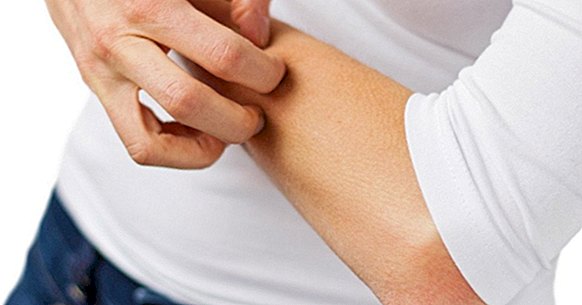Morgellons syndrome: symptoms, treatment and theories that explain it
In the year 2001, Mary Leitao, biologist and mother of a 7 year old boy. He discovered that his son had unique skin sores in which strange fibers of unknown origin could be seen. After a tireless search for diagnoses and unresolved answers, she coined this condition as Morgellons syndrome.
Morgellons syndrome is a mysterious and highly controversial disease , for which today no answers have yet been found supported by the entire scientific community, and around which circulate all kinds of scientific and conspiratorial theories.
- The 16 most common mental disorders "
What is Morgellons syndrome?
Morgellons syndrome or disease is a strange condition , whose name was coined relatively recently, in which the affected person suffers a series of delusions in which it is believed to be contaminated by infectious pathogens. These elements can be insects, parasites or a series of strange fibers that they claim to have under the skin.
These delusions can be reinforced by the fact that, in certain cases, they have been observed a series of foreign fibers present in the skin lesions that the person causes himself .
Self-injuries are common in Morgellons patients, who manifest a constant obsession with scratching or even nibbling their skin with the intention of relieving the sensations of tingling or itching they refer to feel.
Morgellons syndrome has turned out to be a disease surrounded by controversies and discussions within the medical and scientific community. The reason is that part of this community distinguishes it as a new disease with its own symptoms, while others consider it a new type of manifestation of a known disorder, dermatological parasitic delirium .
The mystery and controversy surrounding the Morgellons syndrome is such that conspiracy theories have been established around it, which describe it as a disease caused by the same governments or companies through the use of nanotechnology. Which, according to them, would explain the appearance of the fibers under the skin and the constant tingling.
Symptoms and diagnosis
Since, for the moment, Morgellons syndrome is not accepted as a delimited disease, there is no record of its symptoms, nor nor have the guidelines been developed to be able to perform a differential diagnosis accepted from this.
According to the Morgellons Research Foundation (MRF), in the list of symptoms you can find:
- Tingling, itching or constant itching on the skin that is irritating to the person.
- Skin rashes and wounds that do not heal correctly.
- Appearance of a species of fibers or threads, of unknown cause, in the skin that can also appear below this or in the skin lesions.
- Exhausted.
- Cognitive deficits as lack of concentration or memory loss.
Likewise, symptoms associated with chronic fatigue syndrome, symptoms of depression or obsessive-compulsive disorder (OCD) have been recorded in a large number of patients affected by this strange disorder.
- Related article: "Ekbom syndrome (delirium of parasitosis): causes and symptoms"
Possible causes of the syndrome
Given the great disagreement and little research that exists around the Morgellons syndrome, a series of hypotheses and theories about its origin have been established. Some of them are based on possible cutaneous diseases, while others are based on the effect that certain bacteria or toxins have on people.
1. Dermatozoic parasitic delirium and other neurological disorders
As discussed above, a part of the scientific community, including dermatologists and psychiatrists, consider Morgellons syndrome a new version of the well-known parasitic dermatozoic delirium, also known as delirium of infestation. According to psychiatric diagnosis manuals, these disorders are included in the category "delusional disorders without specification" .
Likewise, the scientific community affirms that people suffering from Morgellons syndrome are characterized by manifesting a symptomatology very similar to that of parasitic dermatozoic delirium, which is why most of them are diagnosed as such.
This parasitic delirium stands out for infusing, in the people who suffer it, the delirious belief that they are infested by all kinds of bacteria or parasitic agents, which cause them that tingling sensation and itching under the skin .
Patients suffering from this disorder can develop self-harm or self-mutilation behaviors, they carry out with the purpose of "plucking" or removing from their body those parasites . Due to this obsession, patients delve more and more into their wounds making it impossible to heal them.
In certain cases of delirium, the cause of delirium is found in certain allergies, cutaneous carcinomas, herpes zoster or even in some women in the stage of menopause. In those that the cutaneous sensations are real, but the attribution that the subjects give him is irrational.
2. Skin conditions
Other hypotheses by which the Morgellons attempt to find the cause suggest that the basis of this alteration is found in certain skin disorders such as allergic dermatitis , contact dermatitis or scabies, also known as scabies.
As in the previous point, the person feels a real itch on the skin, but maintains the delusional belief that it is not a skin disease but that it is infected by parasites.
3. Bacterial hypothesis
In a research published in 2006m in the American Journal of Clinical Dermatology, it was claimed that Morgellons disease could be linked to an undefined infectious process . Likewise, they also testified that in many of the patients affected by Morgellons syndrome the same bacteria that cause Lyme disease had been found.
The following year, the same researchers claimed that the fibers found in the skin lesions of the patients contained cellulose, while a more detailed analysis of these fibers revealed the appearance of a bacterium known as Agrobacterium . This pathogen is typical of the plant world, and is known to originate a series of cellulose fibers in the plants it infects. If this theory is true, Morgellons syndrome would be the first case in which a bacterium from the plant world affects humans.
- Maybe you're interested: "The 3 types of bacteria (characteristics and morphology)"
Treatment
In most cases the Morgellons syndrome shares the same treatment as parasite delirium, as many professionals consider it as such.
After a medical examination to rule out organic causes, a series of typical antipsychotics is given , such as olanzapine and risperidone.
Since many of the patients reject the diagnosis of a psychotic disorder, they oppose psychiatric treatment. So based on the theories of infectious agents and bacteria, many patients are treated with antibiotic or antiparasitic medication; which would act on patients through the placebo effect.



















